Grand Space 3F, Taipei Marriott Hotel
No. 199, Lequn 2nd Rd., ZhongShan Dist., Taipei City, Taiwan

|
Lot: 601
D: 14.5 cm |
Estimate
30,000 - 80,000 1,000 - 2,700 8,000 - 21,000
|
Sold Price
72,000
2,392
18,653
|

|
Lot: 602
D: 11 cm H: 2.8 cm |
Estimate
10,000 - 20,000 300 - 700 3,000 - 5,000
|
Sold Price
8,400
279
2,176
|
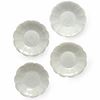
|
Lot: 603
D: 11 cm x 4 |
Estimate
300,000 - 500,000 9,900 - 16,600 77,000 - 129,000
|
|
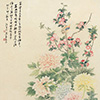
|
Lot: 604
1891 |
Estimate
320,000 - 480,000 10,600 - 15,900 82,000 - 123,000
|
|
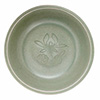
|
Lot: 605
D: 12.5 cm |
Estimate
80,000 - 180,000 2,700 - 6,000 21,000 - 46,000
|
Sold Price
192,000
6,379
49,741
|
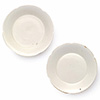
|
Lot: 606
D: 10.5 cm |
Estimate
320,000 - 480,000 10,600 - 15,900 82,000 - 123,000
|
|

|
Lot: 607
D: 12.5 cm |
Estimate
200,000 - 360,000 6,600 - 11,900 51,000 - 93,000
|
|

|
Lot: 608
D: 13.5 cm |
Estimate
30,000 - 80,000 1,000 - 2,700 8,000 - 21,000
|
Sold Price
120,000
3,987
31,088
|

|
Lot: 609
XING D:7cm |
Estimate
200,000 - 300,000 6,600 - 9,900 51,000 - 77,000
|
|

|
Lot: 610
D1: 10 cm H1: 3cm |
Estimate
150,000 - 200,000 5,000 - 6,600 39,000 - 51,000
|
|
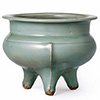
|
Lot: 611
D: 15.6 cm |
Estimate
2,600,000 - 3,600,000 86,100 - 119,300 668,000 - 925,000
|
Sold Price
2,880,000
95,681
746,114
|
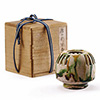
|
Lot: 612
H: 6 cm |
Estimate
460,000 - 600,000 15,200 - 19,900 118,000 - 154,000
|
Sold Price
552,000
18,339
143,005
|

|
Lot: 613
H: 9 cm |
Estimate
60,000 - 160,000 2,000 - 5,300 15,000 - 41,000
|
Sold Price
204,000
6,777
52,850
|

|
Lot: 614
D: 12 cm |
Estimate
650,000 - 900,000 21,500 - 29,800 167,000 - 231,000
|
|
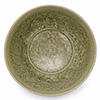
|
Lot: 615
D: 14.5 cm |
Estimate
300,000 - 500,000 9,900 - 16,600 77,000 - 129,000
|
|
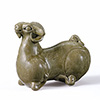
|
Lot: 616
H: 10 cm |
Estimate
1,200,000 - 1,800,000 39,800 - 59,600 308,000 - 463,000
|
|
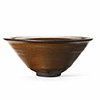
|
Lot: 617
D: 13.1 cm |
Estimate
260,000 - 400,000 8,600 - 13,300 67,000 - 103,000
|
|

|
Lot: 618
D: 10 cm |
Estimate
100,000 - 200,000 3,300 - 6,600 26,000 - 51,000
|
Sold Price
84,000
2,791
21,762
|
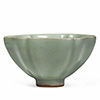
|
Lot: 619
D: 9.8 cm |
Estimate
700,000 - 1,200,000 23,200 - 39,800 180,000 - 308,000
|
|

|
Lot: 620
D: 12.3 cm |
Estimate
500,000 - 800,000 16,600 - 26,500 129,000 - 206,000
|
|

|
Lot: 621
D: 13.5 cm |
Estimate
60,000 - 160,000 2,000 - 5,300 15,000 - 41,000
|
Sold Price
156,000
5,183
40,415
|
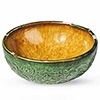
|
Lot: 622
D: 9.6 cm |
Estimate
200,000 - 280,000 6,600 - 9,300 51,000 - 72,000
|
|

|
Lot: 623
H: 31 cm |
Estimate
1,800,000 - 2,400,000 59,600 - 79,500 463,000 - 617,000
|
|

|
Lot: 624
H: 55 cm |
Estimate
6,500,000 - 8,000,000 215,400 - 265,100 1,671,000 - 2,057,000
|
Sold Price
7,800,000
259,136
2,020,725
|
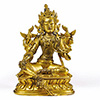
|
Lot: 625
H: 18 cm |
Estimate
700,000 - 900,000 23,200 - 29,800 180,000 - 231,000
|
Sold Price
840,000
27,907
217,617
|

|
Lot: 626
L: 31 cm |
Estimate
1,100,000 - 1,800,000 36,400 - 59,600 283,000 - 463,000
|
|
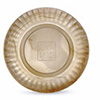
|
Lot: 627
H: 4 cm |
Estimate
380,000 - 600,000 12,600 - 19,900 98,000 - 154,000
|
Sold Price
552,000
18,339
143,005
|

|
Lot: 628
9.9x 9.9 x 9.5 cm |
Estimate on request |
|
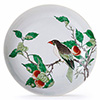
|
Lot: 629
D: 21.1 cm |
Estimate
6,500,000 - 12,000,000 215,400 - 397,600 1,671,000 - 3,085,000
|
|
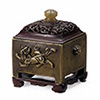
|
Lot: 630
H: 6.5 cm |
Estimate
200,000 - 300,000 6,600 - 9,900 51,000 - 77,000
|
Sold Price
240,000
7,973
62,176
|

|
Lot: 631
H: 20 cm |
Estimate
240,000 - 380,000 8,000 - 12,600 62,000 - 98,000
|
|

|
Lot: 632
H: 7.5 cm |
Estimate
900,000 - 1,600,000 29,800 - 53,000 231,000 - 411,000
|
|
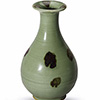
|
Lot: 633
H: 18 cm |
Estimate
460,000 - 700,000 15,200 - 23,200 118,000 - 180,000
|
|
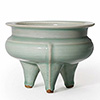
|
Lot: 634
H: 11.7 cm |
Estimate
700,000 - 900,000 23,200 - 29,800 180,000 - 231,000
|
|

|
Lot: 635
H: 16.5 cm |
Estimate
30,000 - 60,000 1,000 - 2,000 8,000 - 15,000
|
Sold Price
36,000
1,196
9,326
|
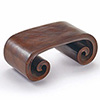
|
Lot: 636
H: 6 cm |
Estimate
30,000 - 60,000 1,000 - 2,000 8,000 - 15,000
|
Sold Price
36,000
1,196
9,326
|
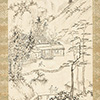
|
Lot: 637
Ink on paper |
Estimate
180,000 - 260,000 6,000 - 8,600 46,000 - 67,000
|
Sold Price
216,000
7,176
55,959
|
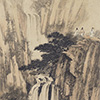
|
Lot: 638
Ink on paper |
Estimate
1,600,000 - 2,200,000 53,000 - 72,900 411,000 - 566,000
|
Sold Price
1,920,000
63,787
497,409
|

|
Lot: 639
1972 |
Estimate
850,000 - 1,200,000 28,200 - 39,800 219,000 - 308,000
|
|
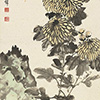
|
Lot: 640
1965 |
Estimate
1,100,000 - 1,600,000 36,400 - 53,000 283,000 - 411,000
|
|

|
Lot: 641
1948 |
Estimate
1,000,000 - 1,600,000 33,100 - 53,000 257,000 - 411,000
|
|
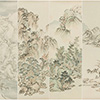
|
Lot: 642
2016 |
Estimate
380,000 - 480,000 12,600 - 15,900 98,000 - 123,000
|
Sold Price
456,000
15,150
118,135
|

|
Lot: 643
1980 |
Estimate
850,000 - 1,000,000 28,200 - 33,100 219,000 - 257,000
|
|

|
Lot: 645
1981 |
Estimate
480,000 - 600,000 15,900 - 19,900 123,000 - 154,000
|
|
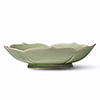
|
Lot: 646
D: 15.5 cm |
Estimate
500,000 - 600,000 16,600 - 19,900 129,000 - 154,000
|
|
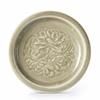
|
Lot: 647
D: 19 cm |
Estimate
220,000 - 300,000 7,300 - 9,900 57,000 - 77,000
|
|
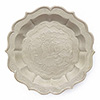
|
Lot: 648
D: 13.5 cm |
Estimate
300,000 - 400,000 9,900 - 13,300 77,000 - 103,000
|
|

|
Lot: 649
2016 |
Estimate
280,000 - 400,000 9,300 - 13,300 72,000 - 103,000
|
Sold Price
432,000
14,352
111,917
|
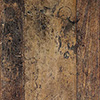
|
Lot: 650
L: 189 cm |
Estimate
360,000 - 550,000 11,900 - 18,200 93,000 - 141,000
|
|

|
Lot: 651
L: 96.5 cm |
Estimate
700,000 - 1,200,000 23,200 - 39,800 180,000 - 308,000
|
|

|
Lot: 652
D: 19 cm |
Estimate
360,000 - 550,000 11,900 - 18,200 93,000 - 141,000
|
|
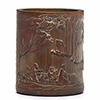
|
Lot: 653
H: 14.7 cm |
Estimate
650,000 - 750,000 21,500 - 24,900 167,000 - 193,000
|
|
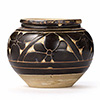
|
Lot: 654
H: 9 cm |
Estimate
70,000 - 120,000 2,300 - 4,000 18,000 - 31,000
|
|

|
Lot: 655
D: 6.6 cm |
Estimate
180,000 - 360,000 6,000 - 11,900 46,000 - 93,000
|
|
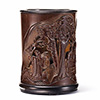
|
Lot: 656
H: 16 cm |
Estimate
800,000 - 1,200,000 26,500 - 39,800 206,000 - 308,000
|
|
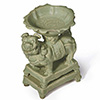
|
Lot: 657
H: 13.8 cm |
Estimate
550,000 - 800,000 18,200 - 26,500 141,000 - 206,000
|
|

|
Lot: 658
H: 25 cm |
Estimate
850,000 - 1,200,000 28,200 - 39,800 219,000 - 308,000
|
Sold Price
1,020,000
33,887
264,249
|

|
Lot: 659
A ZANABAZAR SCHOOL GILT ROSE COPPER FIGURE OF BUDDHA GAUTAMA FROM KHALKHA MONGOLS
17th - 18th Century H: 22 cm |
Estimate
2,800,000 - 3,600,000 92,800 - 119,300 720,000 - 925,000
|
|

|
Lot: 660
H: 17 cm |
Estimate
1,000,000 - 1,500,000 33,100 - 49,700 257,000 - 386,000
|
Sold Price
1,920,000
63,787
497,409
|

|
Lot: 661
H: 10 cm |
Estimate
650,000 - 800,000 21,500 - 26,500 167,000 - 206,000
|
Sold Price
780,000
25,914
202,073
|
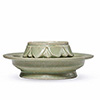
|
Lot: 662
D: 14 cm |
Estimate
600,000 - 800,000 19,900 - 26,500 154,000 - 206,000
|
|

|
Lot: 663
D: 12.3 cm |
Estimate
3,200,000 - 8,000,000 106,000 - 265,100 823,000 - 2,057,000
|
|
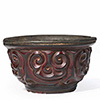
|
Lot: 664
D: 6.5 cm |
Estimate
280,000 - 400,000 9,300 - 13,300 72,000 - 103,000
|
|
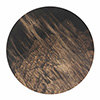
|
Lot: 665
2013 |
Estimate
80,000 - 1,200,000 2,700 - 4,000 21,000 - 31,000
|
Sold Price
96,000
3,189
24,870
|
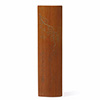
|
Lot: 666
L: 17.4 cm |
Estimate
30,000 - 50,000 1,000 - 1,700 8,000 - 13,000
|
Sold Price
36,000
1,196
9,326
|
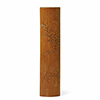
|
Lot: 667
L: 27.2 cm |
Estimate
70,000 - 120,000 2,300 - 4,000 18,000 - 31,000
|
|

|
Lot: 668
D: 17.5 cm |
Estimate
380,000 - 600,000 12,600 - 19,900 98,000 - 154,000
|
|

|
Lot: 669
L: 15 cm |
Estimate
550,000 - 800,000 18,200 - 26,500 141,000 - 206,000
|
|
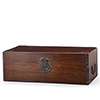
|
Lot: 670
L: 41cm |
Estimate
80,000 - 160,000 2,700 - 5,300 21,000 - 41,000
|
Sold Price
96,000
3,189
24,870
|
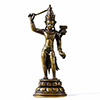
|
Lot: 671
H: 15 cm |
Estimate
750,000 - 900,000 24,900 - 29,800 193,000 - 231,000
|
|
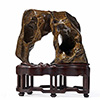
|
Lot: 672
L: 30 cm |
Estimate
180,000 - 300,000 6,000 - 9,900 46,000 - 77,000
|
Sold Price
216,000
7,176
55,959
|
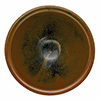
|
Lot: 673
D: 12 cm |
Estimate
240,000 - 380,000 8,000 - 12,600 62,000 - 98,000
|
|

|
Lot: 674
D: 15.5 cm |
Estimate
120,000 - 180,000 4,000 - 6,000 31,000 - 46,000
|
|
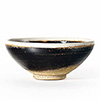
|
Lot: 675
H: 4.5 cm |
Estimate
50,000 - 80,000 1,700 - 2,700 13,000 - 21,000
|
|
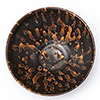
|
Lot: 676
D: 11 cm |
Estimate
110,000 - 220,000 3,600 - 7,300 28,000 - 57,000
|
|

|
Lot: 677
D: 11.2 cm |
Estimate
180,000 - 280,000 6,000 - 9,300 46,000 - 72,000
|
Sold Price
216,000
7,176
55,959
|
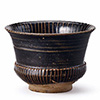
|
Lot: 678
D: 13.5 cm |
Estimate
100,000 - 200,000 3,300 - 6,600 26,000 - 51,000
|
|
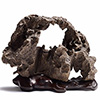
|
Lot: 679
L: 15.5 cm |
Estimate
150,000 - 300,000 5,000 - 9,900 39,000 - 77,000
|
Sold Price
180,000
5,980
46,632
|

|
Lot: 680
D: 14 cm |
Estimate
30,000 - 60,000 1,000 - 2,000 8,000 - 15,000
|
|
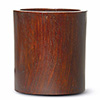
|
Lot: 681
H:14 cm W: 12 cm |
Estimate
160,000 - 260,000 5,300 - 8,600 41,000 - 67,000
|
|
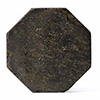
|
Lot: 682
D: 10 cm |
Estimate
1,100,000 - 1,600,000 36,400 - 53,000 283,000 - 411,000
|
|
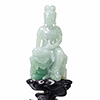
|
Lot: 683
Sculpture, Natural Jadeite Jade – Type A |
Estimate
800,000 - 1,200,000 26,500 - 39,800 206,000 - 308,000
|
|

|
Lot: 684
2014 |
Estimate
220,000 - 380,000 7,300 - 12,600 57,000 - 98,000
|
Sold Price
264,000
8,771
68,394
|
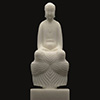
|
Lot: 685
2017 |
Estimate
260,000 - 380,000 8,600 - 12,600 67,000 - 98,000
|
Sold Price
312,000
10,365
80,829
|
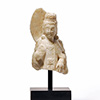
|
Lot: 686
H: 16 cm (21 cm with stand) |
Estimate
240,000 - 360,000 8,000 - 11,900 62,000 - 93,000
|
|
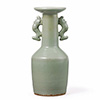
|
Lot: 687
H: 26.5 cm |
Estimate
700,000 - 900,000 23,200 - 29,800 180,000 - 231,000
|
Sold Price
840,000
27,907
217,617
|
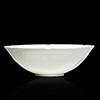
|
Lot: 688
D: 20 cm |
Estimate
850,000 - 1,200,000 28,200 - 39,800 219,000 - 308,000
|
|

|
Lot: 689
2010 |
Estimate
280,000 - 400,000 9,300 - 13,300 72,000 - 103,000
|
|

|
Lot: 690
1987 |
Estimate
80,000 - 120,000 2,700 - 4,000 21,000 - 31,000
|
|
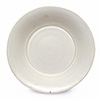
|
Lot: 691
D: 12.3 cm |
Estimate
360,000 - 480,000 11,900 - 15,900 93,000 - 123,000
|
|
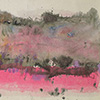
|
Lot: 692
2015 |
Estimate
500,000 - 700,000 6,600 - 23,200 129,000 - 180,000
|
Sold Price
660,000
21,927
170,984
|

|
Lot: 693
2011 |
Estimate
80,000 - 120,000 2,700 - 4,000 21,000 - 31,000
|
Sold Price
180,000
5,980
46,632
|

|
Lot: 694
2001 |
Estimate
400,000 - 600,000 13,300 - 19,900 103,000 - 154,000
|
Sold Price
480,000
15,947
124,352
|
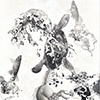
|
Lot: 695
Ink on paper |
Estimate
120,000 - 180,000 4,000 - 6,000 31,000 - 46,000
|
Sold Price
144,000
4,784
37,306
|

|
Lot: 696
D: 4 cm |
Estimate
220,000 - 300,000 7,300 - 9,900 57,000 - 77,000
|
Sold Price
264,000
8,771
68,394
|